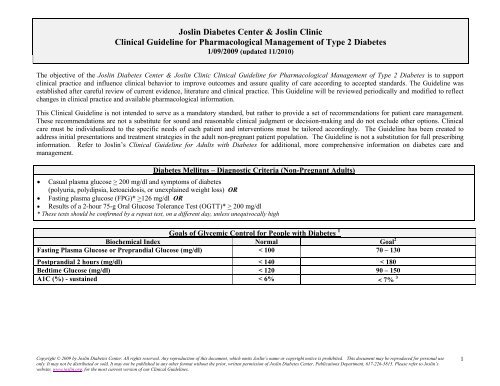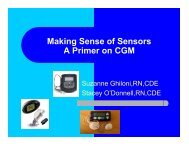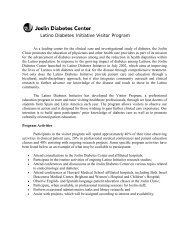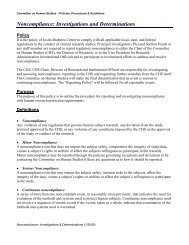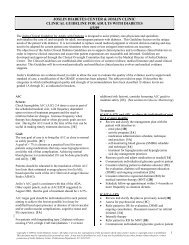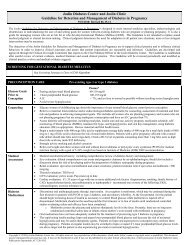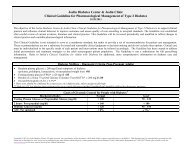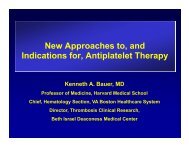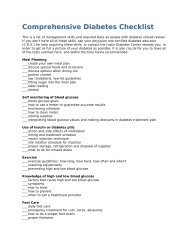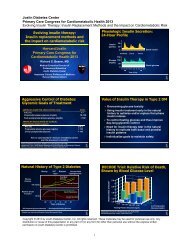Joslin Diabetes Center & Joslin Clinic Clinical Guideline for ...
Joslin Diabetes Center & Joslin Clinic Clinical Guideline for ...
Joslin Diabetes Center & Joslin Clinic Clinical Guideline for ...
You also want an ePaper? Increase the reach of your titles
YUMPU automatically turns print PDFs into web optimized ePapers that Google loves.
InhaltsverzeichnisModul N1: Mathematik und Statistik ........................................................................................... 3Modul N2: Physik ....................................................................................................................... 4Modul N3: Chemie ...................................................................................................................... 5Modul N4: Physikalische Chemie / Strömungstechnik ................................................................ 7Modul WN 1: Naturwissenschaftliche Grundlagen: Wahlpflicht ................................................... 9Modul O1: Ökologie und Modellbildung .................................................................................... 11Modul O2: Pflanzenökologie und Mikrobiologie ........................................................................ 13Modul G1: Lithosphäre ............................................................................................................. 15Modul G2: Hydrosphäre ........................................................................................................... 17Modul G3: Pedosphäre............................................................................................................. 18Modul G4: Atmosphäre............................................................................................................. 20Modul G5: Biosphäre ................................................................................................................ 22Modul G6: Chemosphäre ......................................................................................................... 24Modul P1: Geoökologisches Geländepraktikum: Physikalische Methoden ............................... 27Modul P2:Geoökologisches Geländepraktikum: Standortkundliche Methoden ......................... 29Module WV1 bis WV5: Wahlpflichtveranstaltungen zur Spezialisierung und Vertiefung............ 31Modul BP: Berufspraktikum ...................................................................................................... 33Modul T1: Wissenschaftliche Projektarbeit ............................................................................... 35Modul T2: Bachelorarbeit ......................................................................................................... 36Anhang: Lehrangebot im Wahlpflichtbereich, Module WV1 bis WV5. ...................................... 372
** Also available in fixed combinationsANTIHYPERGLYCEMIC THERAPY , continuedSuggested well-studied combinations based on results ofclinical studies. These do not preclude other combinations: Insulin secretagogue and met<strong>for</strong>min** Sulfonylurea and -glucosidase inhibitor Thiazolidinediones and sulfonylurea** , 9 Thiazolidinediones and met<strong>for</strong>min** , 9 Thiazolidinediones and repaglinide 9 Thiazolidinediones and exenatide 9 Sulfonylurea and exenatide Met<strong>for</strong>min and exenatide Dipeptidyl Peptidase IV Inhibitors and sulfonylurea Dipeptidyl Peptidase IV Inhibitors and met<strong>for</strong>min** Dipeptidyl Peptidase IV Inhibitors and pioglitazone Colesevelam and sulfonylurea Colesevelam and met<strong>for</strong>minContinued on next pageCopyright © 2009 by <strong>Joslin</strong> <strong>Diabetes</strong> <strong>Center</strong>. All rights reserved. Any reproduction of this document, which omits <strong>Joslin</strong>’s name or copyright notice is prohibited. This document may be reproduced <strong>for</strong> personal useonly. It may not be distributed or sold. It may not be published in any other <strong>for</strong>mat without the prior, written permission of <strong>Joslin</strong> <strong>Diabetes</strong> <strong>Center</strong>, Publications Department, 617-226-5815. Please refer to <strong>Joslin</strong>’swebsite, www.joslin.org, <strong>for</strong> the most current version of our <strong>Clinic</strong>al <strong>Guideline</strong>s.4
ANTIHYPERGLYCEMIC THERAPY, continuedA1C > 7.0% ORFasting Plasma Glucose > 130 mg/dl OR2 Hour Postprandial Plasma Glucose > 180 mg/dlAdd:Additional OralAntihyperglycemicMedicationof Different Class 10or Insulin 10,11,12 orConsider starting with. Intermediate-acting insulin (NPH) once or twice daily as part of a conventional program Long-acting insulin (detemir or glargine) once or twice daily <strong>for</strong> basal therapy Pre-supper insulin mixture (75/25 lispro, 50/50 lispro, 50/50 aspart, 70/30 aspart, 70/30 humaninsulin, or 50/50 human insulin)Suggested starting dose <strong>for</strong> injectable insulin: 0.1-0.2 units/kg ideal body weightGLP-1agonist 10Titrate/adjust insulin dosage to achieve glucose goalsIf target glucose not met after 2-4 months, consider: Changing to multidose insulin therapy using combination of rapid, short, intermediate, or long-acting insulin Adding pre-meal rapid or short-acting insulin (e.g. aspart, glulisine, lispro or regular) pre-meals, to bedtimeintermediate or long-acting insulin Adding bedtime basal insulin and adjusting the rapid or short-acting insulin as needed if taking pre-meal insulinand postprandial glucose targets are met, but fasting glucose is elevated Adding oral antihyperglycemic medication to reduce insulin resistance or improve glycemic control if alreadyon insulin (met<strong>for</strong>min, TZDs 13 , sulfonylureas, -glucosidase inhibitors, and colesevelam are approved <strong>for</strong> usein combination with insulin)If post-prandial excursions predominate, refer to endocrinologist <strong>for</strong> intensification of therapy or <strong>for</strong>consideration of pramlintide useCopyright © 2009 by <strong>Joslin</strong> <strong>Diabetes</strong> <strong>Center</strong>. All rights reserved. Any reproduction of this document, which omits <strong>Joslin</strong>’s name or copyright notice is prohibited. This document may be reproduced <strong>for</strong> personal useonly. It may not be distributed or sold. It may not be published in any other <strong>for</strong>mat without the prior, written permission of <strong>Joslin</strong> <strong>Diabetes</strong> <strong>Center</strong>, Publications Department, 617-226-5815. Please refer to <strong>Joslin</strong>’swebsite, www.joslin.org, <strong>for</strong> the most current version of our <strong>Clinic</strong>al <strong>Guideline</strong>s.5
Biguanides liquidmet<strong>for</strong>min*(Riomet) met<strong>for</strong>min(Glucophage) met<strong>for</strong>minextendedrelease(GlucophageXR,Fortamet,Glumetza)(met<strong>for</strong>min andmet<strong>for</strong>min ERavailable asgenericmedication)* Liquid<strong>for</strong>mulation <strong>for</strong>patients unableto swallow pillsTZDs(Thiazolidinediones) pioglitazone(Actos) rosiglitazone(Avandia) 9Oral Antihyperglycemic Medications Available in the USA-GlucosidaseInhibitors acarbose(Precose) miglitol(Glyset)Insulin SecretagoguesSulfonylureas glimepiride (Amaryl) glipizide (Glucotrol) glipizide extendedrelease (Glucotrol XL) glyburide(Micronase, Diabeta) micronized glyburide(Glynase)(glimepiride, glipizideand glyburide areavailable as genericmedications)Non-sulfonylureaMeglitinides repaglinide (Prandin)D-phenylalanineDerivatives nateglinide (Starlix)Dipeptidyl PeptidaseIV Inhibitors(DPP-4 Inhibitors) sitagliptin (Januvia)Bile AcidSequestrant colesevelam(Welchol)FixedCombinations met<strong>for</strong>min and glipizide (Metaglip) met<strong>for</strong>min and glyburide (Glucovance) met<strong>for</strong>min and pioglitazone (Actoplus met) pioglitazone and glimepiride (Duetact) rosiglitazone and glimepiride (Avandaryl) 9 rosiglitazone and met<strong>for</strong>min (Avandamet) 9 sitagliptin and met<strong>for</strong>min (Janumet) repaglinide and met<strong>for</strong>min (PrandiMet)Continued on next pageCopyright © 2009 by <strong>Joslin</strong> <strong>Diabetes</strong> <strong>Center</strong>. All rights reserved. Any reproduction of this document, which omits <strong>Joslin</strong>’s name or copyright notice is prohibited. This document may be reproduced <strong>for</strong> personal useonly. It may not be distributed or sold. It may not be published in any other <strong>for</strong>mat without the prior, written permission of <strong>Joslin</strong> <strong>Diabetes</strong> <strong>Center</strong>, Publications Department, 617-226-5815. Please refer to <strong>Joslin</strong>’swebsite, www.joslin.org, <strong>for</strong> the most current version of our <strong>Clinic</strong>al <strong>Guideline</strong>s.6
INJECTABLE DIABETES MEDICATIONSINSULIN CHART 14Insulin Type Product Onset Peak DurationRapid-ActingInsulin aspart analogInsulin glulisine analogInsulin lispro analogNovoLogApidraHumalog10 – 30 minutes 30 minutes – 3 hours 3 – 5 hoursShort-ActingHuman RegularIntermediate-ActingHuman NPH insulinLong-ActingInsulin detemirInsulin glargineHumulin RNovolin RHumulin NNovolin N30-60 minutes 2 – 5 hours up to 12 hours*90 minutes – 4 hours 4 – 12 hours up to 24 hours**LevemirLantus 45 minutes -4 hours Minimal peak up to 24 hours ***Premixed Insulin CombinationsInsulin Type50% NPH; 50% Regular Humulin 50/5070% NPH; 30% Regular Humulin 70/3070% NPH; 30% Regular Novolin 70/3050% lispro protamine suspension, 50% lispro Humalog Mix 50/5050% aspart protamine suspension, 50% aspart Novolog Mix 50/5075% lispro protamine suspension, 25% lispro Humalog Mix 75/2570% aspart protamine suspension, 30% aspart NovoLog Mix 70/30*Usual clinical relevance can be less than 12 hours** Usual clinical relevance can be less than 24 hours. Often requires twice daily dosing*** Individual response may require twice daily dosingINCRETIN MIMETICS AND NON-INSULIN SYNTHETIC ANALOGSProduct Mechanism of Action Type of <strong>Diabetes</strong> # of Injections Per DayExenatide (Byetta) Incretin mimetic that enhances glucose-dependent insulin secretion and several other2 2antihyperglycemic actions of incretins.Pramlintide (Symlin) Synthetic analog of human amylin, a naturally occurring hormone made in the beta cells, whichslows gastric emptying, suppresses glucagon secretion, and regulates food intake. A significantreduction in insulin dose may be required when insulin is used in conjunction with pramlintide.1 and 2 1-4(with meals)Copyright © 2009 by <strong>Joslin</strong> <strong>Diabetes</strong> <strong>Center</strong>. All rights reserved. Any reproduction of this document, which omits <strong>Joslin</strong>’s name or copyright notice is prohibited. This document may be reproduced <strong>for</strong> personal useonly. It may not be distributed or sold. It may not be published in any other <strong>for</strong>mat without the prior, written permission of <strong>Joslin</strong> <strong>Diabetes</strong> <strong>Center</strong>, Publications Department, 617-226-5815. Please refer to <strong>Joslin</strong>’swebsite, www.joslin.org, <strong>for</strong> the most current version of our <strong>Clinic</strong>al <strong>Guideline</strong>s.7
Footnotes:1 Laboratory methods measure plasma glucose. Most glucose monitors approved <strong>for</strong> home use calibrate whole blood glucose readings to plasma values. Plasma glucosevalues are 10-15% higher than whole blood glucose values. It is important <strong>for</strong> people with diabetes to know whether their meters and strips record whole blood orplasma results.2 Goals should be individualized based on the following, including: co-morbidity, age, duration of diabetes, hypoglycemic awareness.3 The true goal of care is to bring the A1C as close to normal as safely possible. A goal of < 7% is chosen as a practical level <strong>for</strong> most patients using medications thatmay cause hypoglycemia to avoid the risk of that complication. Achieving normal blood glucose is recommended if it can be done practically and safely.4 If diet history reveals markedly excessive carbohydrate intake, may consider initial trial of MNT and physical activity be<strong>for</strong>e initiating oral agent therapy even thoughglucose levels are above the thresholds listed.5 Some patients with type 2 diabetes initially stabilized on insulin may be considered <strong>for</strong> transition to non-insulin anti-hyperglycemic therapy as blood glucose controlpermits.6 A combination of two drugs of different classes may be used as initial pharmacotherapy when there is marked hyperglycemia or when MNT andphysical activity alone have not resulted in an A1C of < 7.0%7 FDA Requirements <strong>for</strong> LFT monitoring <strong>for</strong> thiazolidinediones (TZDs):If initial ALT is > 2.5 times normal, do not start this medicationOnce TZD is started, monitor ALT periodically thereafter according to clinical judgement.If ALT is > 2.5 times normal during treatment, check weekly. If rise persists or becomes 3 times > normal, discontinue TZD.8 Thiazolidinediones cause or exacerbate congestive heart failure in some patients. After initiation of TZDs and after dose increases, observe patients carefully <strong>for</strong> signsand symptoms of heart failure (including excessive, rapid weight gain, dyspnea, and/or edema). If these signs and symptoms develop, the heart failure should bemanaged according to current standards of care. Furthermore, discontinuation or dose reduction of the TZD must be considered. TZDs are not recommended in patientswith symptomatic heart failure or in patients with established NYHA Class III or IV heart failure.9 On September 23, 2010, the Food and Drug Administration (FDA) announced regulatory actions with respect to products containing rosiglitazone: Avandia®(rosiglitazone maleate) Tablets, Avandamet® (rosiglitazone maleate and met<strong>for</strong>min hydrochloride) Tablets and Avandaryl® (rosiglitazone maleate and glimepiride)Tablets. The FDA is requiring GlaxoSmithKline (GSK) to implement restrictions on the use of these products through a program to assure their safe use (i.e., RiskEvaluation and Mitigation Strategy or REMS) and additional safety labeling changes in response to the agency’s review of data that suggest an elevated risk ofcardiovascular events. GSK will be working with the FDA to implement the agency’s requirement <strong>for</strong> a REMS and additional labeling changes. Additional in<strong>for</strong>mationwill be communicated when these measures are finalized. It will take several months to put the REMS program in place. Until the REMS program is in place, the FDA'sdecision allows current or potential users of rosiglitazone to continue or start using the medication after consultation with their health care provider about treatmentoptions. Once the REMS program is in place a) Health care providers will need to be enrolled in the program in order to prescribe rosiglitazone containing products. b)Pharmacists will need to be enrolled in order to dispense rosiglitazone containing products. c) Patients will need to be enrolled in the program by their physician in order<strong>for</strong> them to begin or continue receiving rosiglitazone. d) Health care providers will have to attest to and document their patient's eligibility if they believe that theirpatient is a candidate <strong>for</strong> rosiglitazone. e) Patients will have to review statements describing the cardiovascular safety concerns with rosiglitazone and sign anacknowledgment of their understanding of the in<strong>for</strong>mation. f) Current users of rosiglitazone will only be able to continue using the medication if they acknowledge anddocument that they understand the risks associated with the drug. g) Patients not already taking rosiglitazone can receive the medicine only if they are unable to achieveglycemic control on other medications and, in consultation with their health care provider, decide not to take pioglitazone <strong>for</strong> medical reasons.10 If therapeutic goals are not met, consider starting insulin. Stop exenatide and DPP-IV inhibitor when starting insulin.11 May need to taper and discontinue some or all oral antihyperglycemic medications as insulin is initiated and adjusted, particularly if using short or rapid-acting andbasal insulins.12 Pre- and postprandial blood glucose should be checked. Frequency of checking may vary between 1-4 times/day depending on individual patient and status ofglycemic control.13 There is an increased risk <strong>for</strong> edema when insulin and a thiazolidinedione are used together. Rosiglitazone should not be used in combination with insulin.14 The onset, peak and duration of any insulin type depends on many factors. Patients may experience variations in timing and/or intensity of insulin activity due to dose,site of injection, temperature of the insulin, level of physical activity, in addition to other factors. There<strong>for</strong>e, the time action profile (TAP) should be considered as onlyreasonable estimates of the action of an insulin.Copyright © 2009 by <strong>Joslin</strong> <strong>Diabetes</strong> <strong>Center</strong>. All rights reserved. Any reproduction of this document, which omits <strong>Joslin</strong>’s name or copyright notice is prohibited. This document may be reproduced <strong>for</strong> personal useonly. It may not be distributed or sold. It may not be published in any other <strong>for</strong>mat without the prior, written permission of <strong>Joslin</strong> <strong>Diabetes</strong> <strong>Center</strong>, Publications Department, 617-226-5815. Please refer to <strong>Joslin</strong>’swebsite, www.joslin.org, <strong>for</strong> the most current version of our <strong>Clinic</strong>al <strong>Guideline</strong>s.8
References <strong>for</strong> <strong>Joslin</strong>’s Pharmacological Management of Type 2 <strong>Diabetes</strong> <strong>Guideline</strong>1-9-09Diagnosis1. ADA Position Statement: Diagnosis and Classification of <strong>Diabetes</strong> Mellitus. <strong>Diabetes</strong> Care2009; 32 ( suppl 1): S62-S672. Nathan, DM, Kuenen,J, Borg,H Translating the A1c assay into estimated average glucose values.<strong>Diabetes</strong> Care 2008; 31: 1473-1478Goals of Glycemic Control and Phrmacotherapy1. American <strong>Diabetes</strong> Association. Standards of medical care in diabetes. <strong>Diabetes</strong> Care2009; 32 ( suppl 1): S13-S 613. Beaser, RS and Staff of <strong>Joslin</strong> <strong>Diabetes</strong> <strong>Center</strong>. <strong>Joslin</strong>’s <strong>Diabetes</strong> Deskbook <strong>for</strong> Primary Care Providers. Second edition. <strong>Joslin</strong> <strong>Diabetes</strong> <strong>Center</strong>, Boston; 2007.4. <strong>Diabetes</strong> Prevention and Control Program, <strong>Diabetes</strong> <strong>Guideline</strong>s Work Group. Massachusetts guidelines <strong>for</strong> adult diabetes care. Boston (MA): MassachusettsDepartment of Public Health; 2005 Jun.5. Institute <strong>for</strong> <strong>Clinic</strong>al Systems Improvement (ICSI). Management of type 2 diabetes mellitus. Bloomington (MN): Institute <strong>for</strong> <strong>Clinic</strong>al Systems Improvement(ICS); 2005 Nov.Oral Antihyperglycemic Therapy1. Inzucchi SE. Oral antihyperglycemic therapy <strong>for</strong> type 2 diabetes: scientific review. JAMA 287:360-72, 2002.2. Kimmel B and Inzucchi S. Oral agents <strong>for</strong> type 2 diabetes: an update. <strong>Clinic</strong>al <strong>Diabetes</strong> 23:64-76, 2005.3. Krentz AJ, Bailey CJ. Oral antidiabetic agents. Drugs 2005; 65(3):385-411.4. DeFronzo RA. Pharmacologic therapy <strong>for</strong> type 2 diabetes mellitus. Ann Intern Med 131:281-303, 1999.5. Kahn SE, Haffner SM, Heise MA, et. al. Glycemic Durability of Rosiglitazone, Met<strong>for</strong>min, or Glyburide Monotherapy. New England Journal of Medicine2006; 355: 2427-24436. Nathan, DM et al Medical management of hyperglycemia in type 2 diabetes: A consensus algorithm <strong>for</strong> the initiation and adjustment of therapy. <strong>Diabetes</strong> Care2008; 31: DOI : 10.2337/dc 08-9025Copyright © 2009 by <strong>Joslin</strong> <strong>Diabetes</strong> <strong>Center</strong>. All rights reserved. Any reproduction of this document, which omits <strong>Joslin</strong>’s name or copyright notice is prohibited. This document may be reproduced <strong>for</strong> personal useonly. It may not be distributed or sold. It may not be published in any other <strong>for</strong>mat without the prior, written permission of <strong>Joslin</strong> <strong>Diabetes</strong> <strong>Center</strong>, Publications Department, 617-226-5815. Please refer to <strong>Joslin</strong>’swebsite, www.joslin.org, <strong>for</strong> the most current version of our <strong>Clinic</strong>al <strong>Guideline</strong>s.10
Met<strong>for</strong>min1. Charpentier G, Riveline JP, Varroud-Vial M. Management of drugs affecting blood glucose in diabetic patients with renal failure. <strong>Diabetes</strong> Metab 26 Suppl4:73-85, 2000.2. Cryer DR, Nicholas SP, Henry DH, Mills DJ, Stadel BV. Comparative outcomes study of met<strong>for</strong>min intervention versus conventional approach. <strong>Diabetes</strong> Care28:539-543, 2005.3. Dornan TL, Heller SR, Peck GM, Tattersall RB. Double-blind evaluation of efficacy and tolerability of met<strong>for</strong>min in NIDDM. <strong>Diabetes</strong> Care. 14: 342-343,1991.4. Garber AJ, Duncan TG, Goodman AM, Millis DJ, Rohlf JL Efficacy of Met<strong>for</strong>min in Type II <strong>Diabetes</strong>: Results of a Bouble-Blind, Placebo-controlled, Dose-Response Trial. Am J Med 103:491-497, 1997.5. Grant PJ. The effects of high and medium dose met<strong>for</strong>min therapy on cardiovascular risk factors in patients with type II diabetes. <strong>Diabetes</strong> Care 19: 64-66,1996.6. Holstein A, Stumvoll M. Contraindications can damage your health--is met<strong>for</strong>min a case in point? Diabetologia 48:2454-9, 2005.7. Inzucchi SE. Met<strong>for</strong>min and heart failure: innocent until proven guilty. <strong>Diabetes</strong> Care 28:2585-2587, 2005.8. Johansen K. Efficacy of met<strong>for</strong>min in the treatment of NIDDM. Meta-analysis. <strong>Diabetes</strong> Care 22:33-7, 1999.9. McCormack J, Johns K, Tildesley H. Met<strong>for</strong>min's contraindications should be contraindicated. CMAJ 173:502-4, 2005.10. UKPDS Group. Effect of intensive blood-glucose control with met<strong>for</strong>min on complications in overweight patients with type 2 diabetes (UKPDS 34). Lancet352: 854-865, 1998.11. Saenz A, Fernandez-Esteban I, Mataix A, Ausejo M, Roque M, Moher D. Met<strong>for</strong>min monotherapy <strong>for</strong> type 2 diabetes mellitus. Cochrane Database ofSystematic Reviews 2006 Issue 4.12. Salpeter S., Greyber E, Paternak G., Salpeter E. Risk of fatal and nonfatal lactic acidosis with met<strong>for</strong>min use in type 2 diabetes mellitus. Cochrane DatabaseSys Rev 2006 Issue 4.13. Sulkin TV, Bosman D, Krentz AJ. Contraindications to met<strong>for</strong>min therapy in patients with NIDDM. <strong>Diabetes</strong> Care 20:925-8, 1997.Thiazolidinediones1. Charbonnel1B, Roden M, Urquhart , Mariz S, Johns D, Mihm M, Wide M, Tan M. Pioglitazone elicits long-term improvements in insulin sensitivity in patientswith type 2 diabetes: comparisons with glipazide-based regimens. Diabetologia 48:553-60, 2005.2. Davidson JA, Perez A, Zhang J, The Pioglitazone 343 Study Group. Addition of pioglitazone to stable insulin therapy in patients with poorly controlled type 2diabetes: results of a double-blind, multicentre, randomized study. <strong>Diabetes</strong> Obes Metab 8:164-74, 2006.3. Kulenovic I. Impact of rosiglitazone on glycaemic control, insulin levels and blood pressure values in patients with type 2 diabetes. Med Arh 60:179-81,Copyright © 2009 by <strong>Joslin</strong> <strong>Diabetes</strong> <strong>Center</strong>. All rights reserved. Any reproduction of this document, which omits <strong>Joslin</strong>’s name or copyright notice is prohibited. This document may be reproduced <strong>for</strong> personal useonly. It may not be distributed or sold. It may not be published in any other <strong>for</strong>mat without the prior, written permission of <strong>Joslin</strong> <strong>Diabetes</strong> <strong>Center</strong>, Publications Department, 617-226-5815. Please refer to <strong>Joslin</strong>’swebsite, www.joslin.org, <strong>for</strong> the most current version of our <strong>Clinic</strong>al <strong>Guideline</strong>s.11
2006.4. Miyazaki Y, Mahankali A, Matsuda M et al. Improved glycemic control and enhanced insulin sensitivity in type 2 diabetic subjects treated with pioglitazone.<strong>Diabetes</strong> Care 24:710-719, 2001.5. Nesto RW, Bell D, Bonow RO, Fonseca V, Grundy SM, Horton ES, Le Winter M, Porte D, Semenkovich CF, Smith S, Young LH, Kahn R. American HeartAssociation; American <strong>Diabetes</strong> Association. Thiazolidinedione use, fluid retention, and congestive heart failure: a consensus statement from the AmericanHeart Association and American <strong>Diabetes</strong> Association. Circulation 108:2941-8, 2003.6. Mazzone T, Meyer PM, Feinstein SB, Davidson MH, Kondos GT, D'Agostino RB, Sr. et al. Effect of pioglitazone compared with glimepiride on carotidintima-media thickness in type 2 diabetes: a randomized trial. JAMA 2006; 296(21):2572-2581.7. Yki-Jarvinen, H. Thiazolidinediones. New England Journal of Medicine 2004; 351: 1106-11188 Nissen, SE, Wolski, K . Effect of rosiglitazone on the risk of myocardial infarction and death from cardiovascular causes. New England Journal of Medicine2007; 356: 2457-24719. GlaxoSmithKline. GSK regulatory update on Avandia following EMA and FDA reviews: issued Thursday 23 September 2010. Available at:http://www.gsk.com/media/pressreleases/2010/2010_pressrelease_10103.htm. Accessed September 2010.10. U.S. Food and Drug Administration. Postmarketing drug safety in<strong>for</strong>mation <strong>for</strong> patients and providers. Q&A: Avandia (rosiglitazone). Available at:http://www.fda.gov/Drugs/DrugSafety/PostmarketDrugSafetyIn<strong>for</strong>mation<strong>for</strong>PatientsandProviders/ucm226976.htm. Accessed September 2010.*11. Woodcock J. United Stated Food and Drug Administration, <strong>Center</strong> <strong>for</strong> Drug Evaluation and Research. Decision on continued marketing of rosiglitazone(Avandia, Avandamet, Avandaryl). Available at:http://www.fda.gov/downloads/Drugs/DrugSafety/PostmarketDrugSafetyIn<strong>for</strong>mation<strong>for</strong>PatientsandProviders/UCM226959. Accessed October 2010.*Insulin Secretagogues1. Bailey CJ, Day C. Antidiabetic drugs. Br J Cardiol 10:128-36, 2003.2. Del Prato S, Heine RJ, Keilson L, Guitard C, Shen SG, Emmons RP. Treatment of patients over 64 years of age with type 2 diabetes: experience fromnateglinide pooled database retrospective analysis. <strong>Diabetes</strong> Care 26:2075-80, 2003.3. Dornhorst M. Insulotropic meglitinide analogues. Lancet 358:1709-15, 2001.4. Hazama Y, Matsuhisa M, Ohtoshi K, Gorogawa S, Kato K, Kawamori D, Yoshiuchi K, Nakamura Y, Shiraiwa T, Kaneto H, Yamasaki Y, Hori M. Beneficialeffects of nateglinide on insulin resistance in type 2 diabetes. <strong>Diabetes</strong> Res Clin Pract 71:251-5, 2006.5. Plosker, Gl, Figgitt, DP.Repaglinide: a pharmacoeconomic review of its use in type 2 diabetes mellitus. PharmacoEconomics 22:389-411, 2004.6. Shapiro MS, Abrams Z, Lieberman N. <strong>Clinic</strong>al experience with repaglinide in patients with non-insulin-dependent diabetes mellitus. Isr Med Assoc J. 20057:75-7, 2005.Alpha-Glucosidase InhibitorsCopyright © 2009 by <strong>Joslin</strong> <strong>Diabetes</strong> <strong>Center</strong>. All rights reserved. Any reproduction of this document, which omits <strong>Joslin</strong>’s name or copyright notice is prohibited. This document may be reproduced <strong>for</strong> personal useonly. It may not be distributed or sold. It may not be published in any other <strong>for</strong>mat without the prior, written permission of <strong>Joslin</strong> <strong>Diabetes</strong> <strong>Center</strong>, Publications Department, 617-226-5815. Please refer to <strong>Joslin</strong>’swebsite, www.joslin.org, <strong>for</strong> the most current version of our <strong>Clinic</strong>al <strong>Guideline</strong>s.12
3. Hirsch B, Bergenstal RM, Parkin CG, Wright E, Buse JB. A real-world approach to insulin therapy in primary care practice. Clin <strong>Diabetes</strong> 23: 78-86, 2005.4. Kennedy L, Herman WH, Strange P, Harris A <strong>for</strong> the GOAL A1C Team. Impact of active versus usual algorithmic titration of basal insulin and point-of-careversus laboratory measurement of HbA 1c on glycemic control in patients with type 2 diabetes. <strong>Diabetes</strong> Care 29:1-8, 2006.5. Kudva YC, Basu A, Jenkins GD, Pons GM, Quandt LL, Gebel JA, Vogelsang DA, Smith SA, Rizza RA, Isley WL. Randomized controlled clinical trial ofglargine versus ultralente insulin in the treatment of type 1 diabetes. <strong>Diabetes</strong> Care 28:10-4, 2005.6. Riddle MC. The Treat-to-Target Trial and related studies. Endoc Pract. 37:495-501, 2006.7. Scholtz HE, Pretorious SG, Wessels DH, Becker RH. Pharmacokinetic and glucodynamic variability: assessment of insulin glargine, NPH insulin and insulinultralente in healthy volunteers using a euglycaemic clamp technique. Diabetologia 48:1988-95, 2005.8. Siebenhofer A, Plank J, Berghold A, Jeitler K, Horvath K, Narath M, Gfrerer R, Pieber TR. Short acting insulin analogues versus regular human insulin inpatients with diabetes mellitus. Cochrane Database Syst Rev. 2006 Apr 19;(2):CD003287.9. Taylor R, Davies R, Fox C, Sampson M, Weaver JU, Wood L. Appropriate insulin regimen <strong>for</strong> type 2 diabetes: a multicenter randomized crossover study.<strong>Diabetes</strong> Care 23:1612-18, 2000.10. Valensi P, Cosson E. Is insulin detemir able to favor a lower variability in the action of injected insulin in diabetic subjects? <strong>Diabetes</strong> Metab 31:4S34-4S39,2005.Pramlintide1. Hollander P, Ratner R, Fineman M, Strobel S, Shen L, Maggs D, Kolterman O, Weyer C. Addition of pramlintide to insulin therapy lowers HbA1c inconjunction with weight loss in patients with type 2 diabetes approaching glycaemic targets. <strong>Diabetes</strong> Obes Metab 5:408-14, 2003.2. Hollander PA et al. Pramlintide as an adjunct to insulin therapy improves long-term glycemic and weight control in patients with type 2 diabetes: a 1-yearrandomized controlled trial. <strong>Diabetes</strong> Care 26:784-790, 2003.3. Weyer C, Gottlieb A, Kim DD, Lutz K, Schwartz S, Gutierrez M, Wang Y, Ruggles JA, Kolterman OG, Maggs DG. Pramlintide reduces postprandial glucoseexcursions when added to regular insulin or insulin lispro in subjects with type 1 diabetes: a dose-timing study. <strong>Diabetes</strong> Care 26:3074-9, 2003.4. Whitehouse F, Kruger DF, Fineman M, Shen L, Ruggles JA, Maggs DG, Weyer C, Kolterman OG. A randomized study and open-label extension evaluatingthe long-term efficacy of pramlintide as an adjunct to insulin therapy in type 1 diabetes. <strong>Diabetes</strong> Care 25:724-30, 2002.Copyright © 2009 by <strong>Joslin</strong> <strong>Diabetes</strong> <strong>Center</strong>. All rights reserved. Any reproduction of this document, which omits <strong>Joslin</strong>’s name or copyright notice is prohibited. This document may be reproduced <strong>for</strong> personal useonly. It may not be distributed or sold. It may not be published in any other <strong>for</strong>mat without the prior, written permission of <strong>Joslin</strong> <strong>Diabetes</strong> <strong>Center</strong>, Publications Department, 617-226-5815. Please refer to <strong>Joslin</strong>’swebsite, www.joslin.org, <strong>for</strong> the most current version of our <strong>Clinic</strong>al <strong>Guideline</strong>s.15


